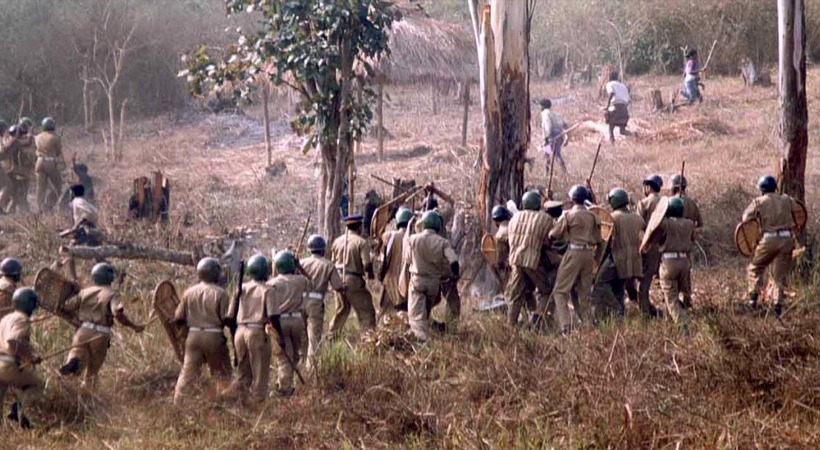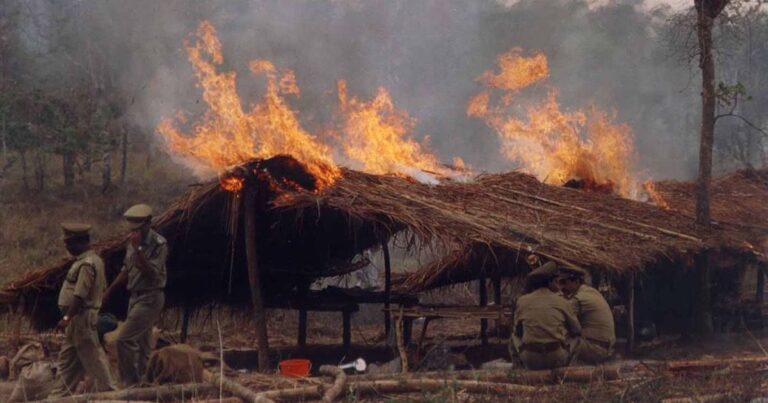
To those cooking the Adivasis’ last supper
February 19, 2003 will go down in Kerala’s history as a day when the combined might of the state machinery, institutions, and ‘civilised’ society would bear down to crush the weakest among the state’s indigenous peoples, because they dared to assert their rights in the face of persistent poverty and exploitation.
The recent Malayalam film Naravetta, which revolves around the Muthanga land agitation, has sparked discussions on the politics of tribal communities and their multiple deprivations.
The Muthanga agitation started as a struggle that revived long-pending demands of dispossessed Adivasis in the hill district of Wayanad, seeking the right to land and autonomy. It lasted only 44 days before it was brought to an abrupt and bloody halt by police action, which was widely condemned by citizens’ groups and prominent figures nationwide. Police firing at the main protest site led to the death of Jogi, one of the Adivasi protestors, while Vinod, a police constable, succumbed to injuries he received during the clash between the police and protestors that preceded it.
The protestors at Muthanga have consistently asserted that theirs was not just a land rights struggle; it was equally about dignity, self-sufficiency, self-governance, and a life free from exploitation that harks back to the traditional life of the tribal people. Paul Zacharia was among the few writers and activists who condemned the state violence against the tribals. This was his response following the police firing on the nonviolent protest.
How does the machinery of the state–politicians, bureaucrats, cultural brokers, nostalgic idealists, even self-proclaimed environmentalists–justify accusing Adivasis of encroachment? From what dark and decaying recess of conscience—if such a thing still exists—did they draw this venom and pour it across the land?
To call the tribal a trespasser in the forest is to accuse the fish of invading water. Just imagine! Cultural elites screaming: “What absurdity is this! The fish we fry now dare to swim in our sacred river. This river is our heritage, our ecosystem. Where are the police, the soldiers? Drive these invaders out!”
For Adivasis, the forest is not merely a resource—it is home. It is where life begins, where daily living unfolds, and where ancestors are laid to rest. For generations, their lives have been deeply intertwined with the rhythms of nature—living among trees, birds, and wild animals.
Indigenous communities across Australia, Africa, the Arctic, and the Sahara share similar histories. They are part of a global lineage—people who have long held knowledge of the earth and its ecosystems.
In central Kerala, too, tribal communities once lived in dense forests. Today, both the forests and many of their inhabitants are gone. What happened?

Upper caste ancestors, including many who now claim to care about the environment, played a role in the decline. Tribals in central Kerala were overpowered. Their forests were destroyed. Their freedom was taken. Many became bonded laborers, forced to work on land that was once theirs.
Feudal lords, temple trusts, royal families, and aristocrats built estates where forests once grew. Tribals were pushed aside, excluded from a society that took everything from them. Yet the same society consumed the food grown by tribal hands. Food is shaped from the soil. It was eaten, boiled, and shaped into meals, while its makers were left outside, branded untouchable.
For a time, the tribals living in the hills remained untouched by conquest. The ancestors of the upper castes showed little interest in the tough, isolated life of the mountains. They preferred the comfort of places like Vanchinadu and Valluvanadu, far from the dense forests.
But change arrived with the swing of axes. The ancient teak forests of the hills were cut down. Their wood was used to build Kerala’s nalukettu homes, with their traditional inner courtyards, as well as the mansions and palaces of Europe. Upper castes and colonial powers entered the forests together. Trees were cleared. A fresh wave of invasion took hold.
Forests that once held deep meaning for Adivasis were seized. Feudal landlords and colonial rulers claimed them. Then came the Forest Department, tightening control like a rope around the neck. Tribals were forced out, one after another.
After the trees fell, waves of starving migrants arrived. Poverty had pushed them from faraway villages. They flooded into tribal lands with empty hands and hollow stomachs. They brought no shared religion or caste. What held them together was hard labor—constant, punishing work. And with that labor came a new kind of pressure on the land.
British-owned plantations transformed parts of the Western Ghats into ‘Little Englands’, while state agencies like the Forest Department and Electricity Board continued to clear land and dam rivers. Timber fed the needs of an expanding society; electricity from submerged forests powered homes across central Kerala.
In towns and cities, cultural figures mourned environmental loss through poetry and prose. Yet many of these works were penned at desks made from forest wood, in homes built with riverbed sand. Once modern comforts were secured, some of these voices adopted the mantle of environmentalism, lamenting deforestation and ecological collapse, often without acknowledging the long history of dispossession behind it.
In places like Agali, Attappadi, Peppara, and Idukki, politicians who seized public office and officials who looted public funds deceived tribal communities. Large swaths of land and massive wealth were taken in the name of the Adivasis. After five decades of so-called solutions offered by elected representatives, the only legacy left for tribal people was a new meaning in the Malayalam dictionary. “Attappadi” came to mean someone with nothing.

Cultural figures from Kerala’s public imagination, working hand in hand with political leaders, began calling returning tribal families “encroachers.” While chanting sacred verses laced with caste pride, they accused the Adivasis of damaging the environment. Cultural narratives were manipulated, passed along to politicians, and used to turn language once meant for freedom into a weapon of betrayal.
The sighs and sentimental memories of a time when upper-caste landlords ruled the forest have now turned into cultural poison aimed at tribal communities. The resentment runs deep. The tribals are not a market for poetry, speeches, or books. They do not create fan clubs. They do not gather at lectures or contribute to cultural fame. For the cultural elite, the scattered Attappadis across Kerala offer no recognition, no reward.
As writer Arundhati Roy pointed out, it is the never-ending delay in justice that has pushed tribal communities into open conflict with the state. But is this the first time people in Kerala have acted outside the law? Is it the first time a police officer has died in service?
Even so, Malayalam news outlets portrayed the tribal protest, roughly the size of a college student group, as if it were an act of war. The protesters were labeled with the same tired terms used by authoritarian regimes: “terrorists,” “extremists.” And amid all the noise, there was silence—intentional and loaded. “Listen to the profound silence of the kind and lovable— a Dalit—human God, Amritanandamayi.”
The alleged ‘crime’ of C.K. Janu and those who stood with her lay in refusal. No allegiance to the UDF or the LDF, twin pillars of a political order that had sidelined tribal communities for over half a century. Cultural gatekeepers balked at the idea of forest reclamation. Politicians bristled at disobedience. The cost of resistance arrived swiftly.
The police force under A.K. Antony launched an attack on the tribal camp as though it were an international war zone. But even an ant, when threatened, will bite. And still, a single finger is enough to crush it.
Inside the Secretariat, ten times as many officials idle behind desks, trading favours for envelopes. No battalions are dispatched there. The Chief Minister, unwilling to confront institutional decay, directs a moral crusade elsewhere, toward the Adivasis, branded as pests.
Ministers, political leaders, and police who tremble before the stockpiles of weapons amassed in the name of religion and fascist politics now charge at tribal women wielding kitchen knives and sickles, parading them as if they were biological weapons.
To support this narrative, Malayalam newspapers revive a long-standing fear—the figure of the Paraya, the outcaste man from folklore, said to lure upper-caste women. Full-color photos fill the pages, fanning panic. Fear of the Adivasi becomes a marketable story, ready to be sold to those in power and those chasing popularity.
“The locals” caught Janu. A more accurate term might be manhunters. Kerala has never lacked them—in alleyways or newsrooms. The same ‘locals’ and the same media who once crucified Ajitha and Mariam Rasheed now paint Janu as a wild witch poised to devour Kerala. Let’s strip her, reach out, touch—how deliciously scandalous! What fun for the voyeur’s eye!
In a way, this is indeed the end of the world. By silencing Janu and crushing the independent tribal movement, the Malayali is setting fire to the true heritage gifted by Adivasis. But for the state, it’s just a day’s work. Just one young policeman’s life. Just the small matter of fabricating charges to keep a tribal woman behind bars, at least until their term in office ends. Then, they’ll wash their hands of it.
Just as K. Karunakaran, the then Chief Minister of Kerala, once handed over Mariam Rasheedah and Fauzia to A.K. Antony, the next Chief Minister, A.K. Antony. Both women, later found innocent, were caught in a system where responsibility often shifts without accountability.
But you, Malayalis, who cheer this manhunt—don’t forget: next Onam, when you sit down to tell the tale of Mahabali, when you put on your koti (new dress) and wash your hands clean, every single ball of rice you roll will carry the bitterness of Adivasi blood. That rice you cook today—that Onam feast—is soaked in the blood of those you made vanish.
Translated by R Ramesh
